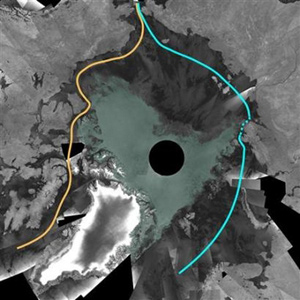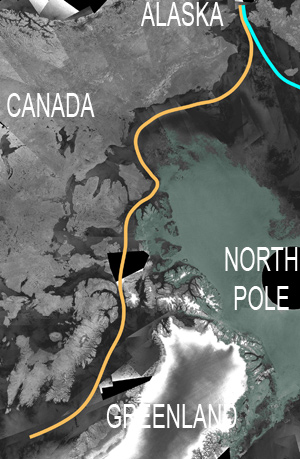Pictures of the ice-free Northwest Passage
Northwest Passage now open for business
mongabay.com
September 15, 2007
Melting sea ice has opened the Northwest Passage in the Arctic to navigation, reports the European Space Agency. The clearing allows direct access between the North Pacific and North Atlantic and could eventually be a cheaper shipping route that the Panama Canal.
Scientists say the Northeast Passage — north of Russia — may soon also be navigable due to disappearing sea ice.
Sea ice cover in the Arctic Ocean is presently 20 percent below its all time lowest extent and may decline further before winter according researchers from the National Snow and Ice Data Center in Boulder (NSIDC). Satellite data shows that the Arctic ice pack covers 4.24 million square kilometers (1.63 million square miles). The previous record low of 5.32 million square kilometers (2.05 million square miles) was set in September 2005.
 In the mosaic image above, created from nearly 200 images acquired in early September 2007 by the Advanced Synthetic Aperture Radar (ASAR) instrument aboard ESA’s Envisat satellite, the dark gray colour represents the ice-free areas while green represents areas with sea ice. The most direct route of the Northwest Passage (highlighted in the top mosaic by an orange line) across northern Canada is shown fully navigable, while the Northeast Passage (blue line) along the Siberian coast remains only partially blocked. To date, the Northwest Passage has been predicted to remain closed even during reduced ice cover by multi-year ice pack — sea ice that survives one or more summers. However, according to Pedersen, this year’s extreme event has shown the passage may well open sooner than expected. |
“We have seen the ice-covered area drop to just around 3 million sq km which is about 1 million sq km less than the previous minima of 2005 and 2006. There has been a reduction of the ice cover over the last 10 years of about 100 000 sq km per year on average, so a drop of 1 million sq km in just one year is extreme,” said Leif Toudal Pedersen from the Danish National Space Center.
“The strong reduction in just one year certainly raises flags that the ice (in summer) may disappear much sooner than expected and that we urgently need to understand better the processes involved.”
Economic interests in melting
The melting has set off a scramble between Canada, Russia, the U.S., Denmark, Sweden and Norway which are all seeking to claim rights to the Arctic’s rich mineral and gas deposits.
The Arctic is particularly sensitive to changes in the extent of sea ice, which helps reflect sunlight back into space, cooling the region. When sea ice melts, the dark areas of open water absorb the sun’s radiation, trigger a positive feedback loop that worsens melting.
Scientists now say that the Arctic could lose all its summer sea ice by 2030, a development that would have implications for wildlife — like polar bear and walrus — that depend on pack ice for feeding.


Envisat ASAR image of the McClure Strait in the Canadian Arctic Archipelago, acquired on 31 August 2007. The McClure Strait is the most direct route of the Northwest Passage and has been fully open since early August 2007.
